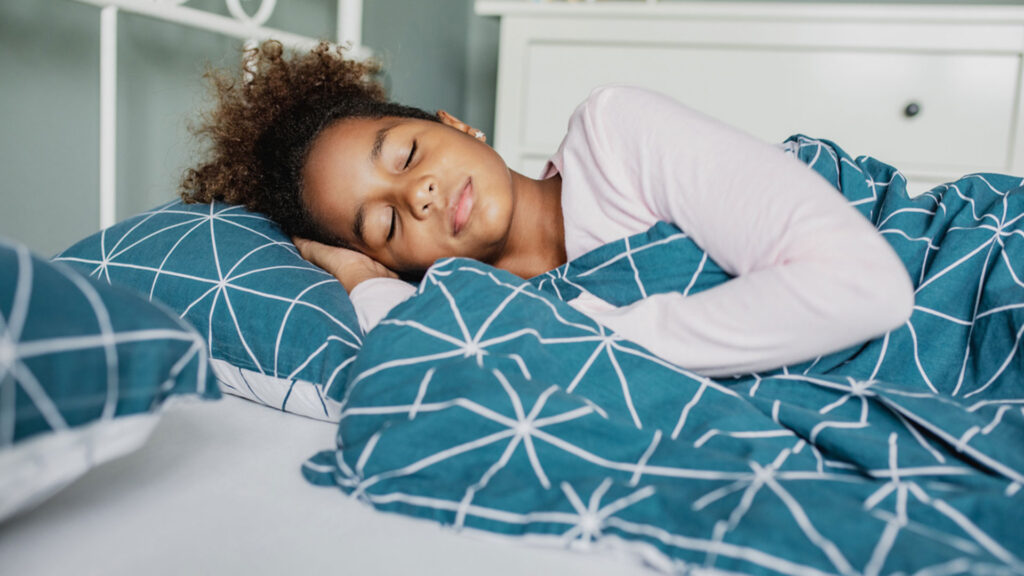
Ask any parent about their biggest kid-related challenges, and odds are good sleep comes up. Babies, toddlers and kids of all ages can experience sleep issues—and that can leave exhausted parents scrambling for solutions. To help everyone get some darn shut-eye, we spoke with Dr. Harvey Karp, a pediatrician and child development expert, for useful tips to get your kids to sleep.
Note: The content on Sleepopolis is meant to be informative in nature, but it shouldn’t be taken as medical advice, and it shouldn’t take the place of medical advice and supervision from a trained professional. If you feel you may be suffering from any sleep disorder or medical condition, please see your healthcare provider immediately.
Long Story Short
- Sleep recommendations for children and adolescents vary depending on their age.
- All children benefit from age-appropriate sleep hygiene practices, including consistent routines, regular activity, limiting screen time, avoiding scary or inappropriate media consumption, and keeping pets out of the bed.
- Like adults, kids and adolescents also benefit from a comfortable, calming sleep environment to minimize distractions and make it easier to drift off.
How Much Sleep Does My Child Need?
Sleep requirements vary depending on a child’s age. The American Academy of Sleep Medicine (AASM) developed the following consensus recommendations for sleep duration in children and adolescents (1):
- Infants 4 months to 12 months: 12 to 16 hours per 24 hours (including naps)
- Children 1 to 2 years of age: 11 to 14 hours per 24 hours (including naps)
- Children 3 to 5 years of age: 10 to 13 hours per 24 hours (including naps)
- Children 6 to 12 years of age: 9 to 12 hours per 24 hours
- Teenagers 13 to 18 years of age: 8 to 10 hours per 24 hours
Teach Good Sleep Hygiene
To put those recommendations into practice, start by teaching your child healthy sleep hygiene practices early—and make them kid friendly.
Create a Consistent Routine
“Babies and children depend on routines and boundaries to feel safe and secure, so having a consistent bedtime routine and sleep/wake times are a must,” Karp tells Sleepopolis. “Plus, using predictable sleep cues as part of a night-night routine helps to get the brain prepared to sleep. Little ones quickly learn that it’s time to wind down their brains and bodies for sleep, which can help keep bedtime battles at bay.”
Maintaining bedtime consistency isn’t limited to easier nights, either (2). Research shows that bedtime routines may contribute to beneficial developmental outcomes, including language and literacy, emotional and behavioral regulation, parent-child attachment, and more (3).
Get Active
Karp recommends outdoor activity in the morning for babies and kids alike. “Not only will toddlers and older children burn energy that’ll help them sleep better in the evening, exposure to morning sunlight lowers the production of the sleep hormone, melatonin, to help children feel awake in the morning,” he says. Of course, daily activity is advisable whether it happens in the morning or not. According to one study, moderate physical activity in children is associated with improved sleep quality (4).
Pick a Screen Time Cutoff
“Turn off screens about 30 to 60 minutes (5) before bedtime,” says Karp. “The blue light from TVs, phones, and tablets can overstimulate tired children and postpone the release of melatonin, which makes the kids feel more awake.” There’s a lot of research supporting his recommendation. A 2019 review of studies indicates that screen time among children and adolescents is associated with delayed bedtimes, reduced sleep quality, shorter total sleep times, longer sleep onset latency, and increased tiredness in the daytime (6). Karp suggests thinking of screen time like candy — “a little is okay every so often, but not a steady diet of it.”
Minimize Scary/Non-age Appropriate Media Consumption
This is an extension of the screen-time recommendation, but minimizing your child’s exposure to violence in the media is also a protective measure. According to the American Academy of Child & Adolescent Psychiatry, the effects of television violence can have a desensitizing effect on children, who may accept it as a way to solve problems or even imitate what they observe (7).
“In the evening, it helps to keep the volume of the TV turned a bit lower and always turn off screens if there’s anything violent or upsetting,” says Karp. “Seeing violence is disturbing for adults, but it’s majorly magnified in the impressionable minds of children — even if it’s in the background and you don’t think your child is watching.”
Keep Pets Out of the Bed
While at least one study has found that it likely isn’t disruptive for older kids to sleep with their pet, it’s not safe for babies or young children (8). “When co-sleeping with the family pet, there’s always a chance a dog (or cat) could get startled and scratch or bite,” Karp points out.
Quick Tips by Age
Children in different age groups, from babies to teenagers, tend to experience specific sleep issues. We quizzed Karp on useful tips for getting kids to sleep based on the most common challenges for their age group.
Babies
During the newborn stage and up to about four months, babies struggle with sleep because their new environment is so different from what they experienced in utero. “That’s why doing your best womb impersonation (using motion, low rumbly white noise, and snug swaddling) can go a long way to soothe crying and boost sleep,” says Karp. He recommends the 5 S’s: swaddling, shushing, swinging, sucking and holding the baby positioned on their side or stomach, or even over your shoulder, for soothing.
“The 5 S’s don’t just mimic the calming sensations experienced in the womb, they activate a newborn’s calming reflex, which is their natural ‘off switch’ for fussing and crying and the ‘on switch’ for sleep,” he explains.
Toddlers
Toddlers are known for their boundless curiosity, and it’s a trait that doesn’t go away at bedtime. Karp recommends reducing as many inside and outside distractions as possible. “Put up blackout curtains, make sure your child’s room is the ideal sleeping temperature (between 68 to 72 degrees Fahrenheit), and use white noise, which creates a blanket of sound that helps mask the sounds of TVs and passing trucks,” he says.
This age group is also susceptible to newfound fears and anxieties about sleeping in the dark or being away from their parent or guardian, so introduce a special stuffed animal, what Karp calls a “lovey.” He says they serve as excellent sleep aids that help children grow in confidence and security. Plus, “they work wonders for easing separation anxiety,” he adds.
Tweens and Teens
Tweens and teens can benefit from standard sleep hygiene practices to help combat any lingering tension or anxieties from the day. “Sleep-helpers like white noise, blackout curtains, morning sunshine, and daily activity continue to work wonders on the sleep front,” says Karp. Stick to a regular sleep/wake cycle, and stay vigilant on the screen time! “Remove iPads and cell phones from bedrooms and implement a strict no-screen rule an hour before lights out,” advises Karp.
Karp recommends the same approach for teens, with an additional note. “If your 12 to 18 year old has a taste for caffeinated beverages (like soda, energy drinks, or coffee), limit their consumption to less than 100 milligrams of caffeine a day,” he says. “And no matter how much or little they’re drinking, cut off caffeine after 3 pm or their sleep may be disturbed.”
Create a Comfortable Sleep Environment
Like adults, kids of all ages benefit from a comfortable, calming sleep environment.
- Minimize distractions. Keeping the bedroom tidy and toys or devices out of sight limits potential distractions and stimulation when it’s time to wind down for sleep.
- Keep it dim, cool and quiet. Room temperature can affect sleep quality, and most experts recommend keeping the bedroom somewhere between 65°F and 72°F. In addition to a cool room, make it as dim as your child will allow to encourage melatonin production. A white noise machine can help mask ambient noise that may be disruptive to your child as they drift off.
- Skip the light-up alarm clock. Older kids may find the clock distracting, especially if they’re waking up in the night and checking the clock. A sunrise alarm clock (especially one with a feature that allows the clock face to be switched off at night) can be a better option.
- Consider aromatherapy. Soothing scents, like lavender and vanilla, may help promote relaxation and a sense of calm. Using a diffuser or even a bedtime lotion are two ways your child could benefit from aromatherapy.
Overcoming Bedtime Fears or Worries
According to Karp, nightmares are common and can begin as early as 2 or 3 years old. He has a few strategies for dealing with nightmares:
- Have your child draw pictures of what’s scaring them the next day. Then let them jump up and down on it or crumple it up.
- Make up a story about a fun character who has a scary dream, and then discuss with your child how to change the dream ending so that it’s funny, not frightening.
- Try role playing: pretend you’re the scared child and your child is the big monster. Then, switch roles so your child is the brave child and you’re the monster.
- Give your child a special stuffed animal to help them feel safe and protected.
- Spritz some plain water around the bed and tell your child it’s a special “monster-go-away” spray.
Keep Your Strategy Consistent
Everyone tends to relax their schedule a bit on the weekends, but consistency with your child’s sleep and wake cycle will make life easier. “Not only do children crave and thrive on routines, predictability helps them understand expectations, relax, and sleep better,” says Karp. Still, he’s the first to point out that weekends are often filled with fun activities that don’t always mesh with your child’s normal sleep routine. “And that’s okay,” he adds. “Parents need to be flexible, too.”
When you get off schedule, he says not to panic. “Simply do your best to use predictable nighttime sleep cues, like dimming the lights, turning on white noise, and reading a bedtime story,” he advises.
When to See A Doctor
First, keep in mind that occasional poor sleep is simply part of growing up. Karp says parents can expect to encounter lots of ups and downs. “But if your child’s sleep is frequently disturbed to the point where they’re not able to get a good night’s rest, have trouble concentrating, or are very sleepy during the day, it’s time to call the pediatrician,” he says. “Other sleep behaviors that you should bring up with a doctor include sudden fearfulness, snoring, suddenly wetting the bed, frequent night terrors, grinding teeth, or pauses in breathing.”
FAQs
How do I help my child sleep alone?
Karp recommends a strategy he calls “Twinkle Interruptus.” To begin, spend a few days helping your child practice patience-stretching techniques during the daytime. “Once your little one has learned to be more patient, try using it at night,” he says. “When you’re just about ready to give good-night kisses, suddenly say, ‘Oh gosh! Wait! Wait! Just one second! I need to check on something! Here, cuddle Mr. Teddy. I’ll be right back!’ Then leave the room for a few seconds before returning.”
When you return, praise your child for waiting patiently. Then, continue with the bedtime routine, but make an excuse to exit once again. “Repeat this a few times, gradually increasing the time your tot is left waiting by a minute or two.” Over several nights, Karp says, you’ll likely find that your toddler has fallen asleep while waiting for your return. “The key, of course, is to always return,” he adds.
How do I help a child relax and sleep?
According to Karp, following a consistent and calming nighttime routine is an excellent strategy for helping children relax into sleep. “About 30 to 60 minutes before bedtime, turn off screens, dim the lights, shut the shades, and turn on white noise to get a child into the sleepy-time mindset,” he says. “Then engage in some sweet, calming activities.”
Once your child is in bed, he advises engaging in soothing bedtime talk. Speaking softly, recount some of your child’s fun experiences from the day and a few things that may happen tomorrow. “Filling your tyke’s sleepy mind with gratitude for all the wonderful things they did nurtures their sense of optimism, making for good dreams and sound sleep,” he says.
The Last Word From Sleepopolis
Sleepless nights, at some point or another, are simply part of the parenthood package. But establishing proper sleep hygiene habits with your children early on can help. Remember that consistency is important, so stick to a regular bedtime routine and sleep/wake times. Make sure that your child is active every day, limit inappropriate or frightening media consumption, and be mindful about screen time. If you’re worried about your child’s sleep habits, speak to your pediatrician.
Karp, Harvey. Personal interview. September 2024.
- Paruthi, S, et al. Recommended Amount of Sleep for Pediatric Populations: A Consensus Statement of the American Academy of Sleep Medicine. Journal of Clinical Sleep Medicine. 2016. https://doi.org/10.5664/jcsm.5866
- Mindell JA, Li AM, Sadeh A, Kwon R, Goh DY. Bedtime routines for young children: a dose-dependent association with sleep outcomes. Sleep. 2015 May 1;38(5):717-22. doi: 10.5665/sleep.4662. PMID: 25325483; PMCID: PMC4402657.
- Mindell JA, Williamson AA. Benefits of a bedtime routine in young children: Sleep, development, and beyond. Sleep Med Rev. 2018 Aug;40:93-108. doi: 10.1016/j.smrv.2017.10.007. Epub 2017 Nov 6. PMID: 29195725; PMCID: PMC6587181.
- Master, L., Nye, R.T., Lee, S. et al. Bidirectional, Daily Temporal Associations between Sleep and Physical Activity in Adolescents. Sci Rep 9, 7732 (2019). https://doi.org/10.1038/s41598-019-44059-9
- Hale L, Kirschen GW, LeBourgeois MK, Gradisar M, Garrison MM, Montgomery-Downs H, Kirschen H, McHale SM, Chang AM, Buxton OM. Youth Screen Media Habits and Sleep: Sleep-Friendly Screen Behavior Recommendations for Clinicians, Educators, and Parents. Child Adolesc Psychiatr Clin N Am. 2018 Apr;27(2):229-245. doi: 10.1016/j.chc.2017.11.014. PMID: 29502749; PMCID: PMC5839336.
- Hale L, Kirschen GW, LeBourgeois MK, Gradisar M, Garrison MM, Montgomery-Downs H, Kirschen H, McHale SM, Chang AM, Buxton OM. Youth Screen Media Habits and Sleep: Sleep-Friendly Screen Behavior Recommendations for Clinicians, Educators, and Parents. Child Adolesc Psychiatr Clin N Am. 2018 Apr;27(2):229-245. doi: 10.1016/j.chc.2017.11.014. PMID: 29502749; PMCID: PMC5839336.
- TV Violence and Children. (2017). https://www.aacap.org/AACAP/Families_and_Youth/Facts_for_Families/FFF-Guide/Children-And-TV-Violence-013.aspx
- Rosano J, Howell T, Conduit R, Bennett P. Co-Sleeping between Adolescents and Their Pets May Not Impact Sleep Quality. Clocks Sleep. 2021 Jan 4;3(1):1-11. doi: 10.3390/clockssleep3010001. PMID: 33406702; PMCID: PMC7838871.




























